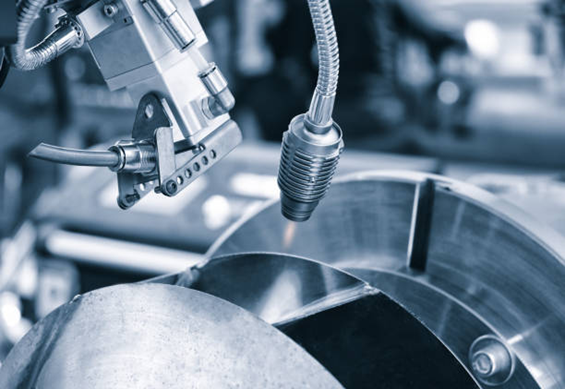
CNC machining of the aerospace part
The aerospace industry upholds high-quality standards, rigorous testing procedures, and strict regulatory requirements to guarantee every component’s functionality, fit, and dependability. Many of the specialized parts used by the aerospace sector are mission-critical due to the nature of flight.
Precision is used in the manufacture and assembly of aircraft so that errors can have little or no negative consequences. CNC machining aerospace parts is an excellent choice because it can produce parts with exact tolerances for both metal and plastic.
This article covers the different things under aerospace parts, including precision and accuracy, applications, machining techniques, and materials. Let’s get right into it!
Overview of the CNC Machining Process for Aerospace Parts
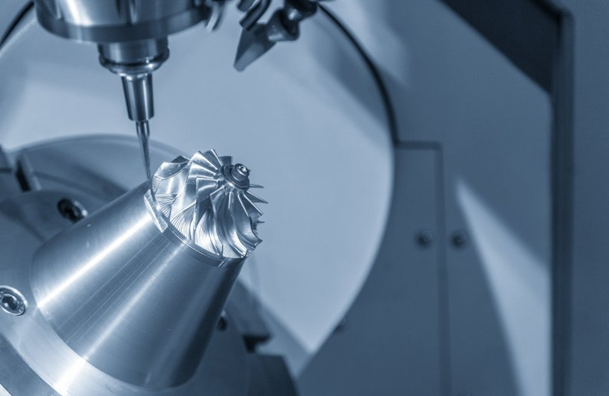
5-axis CNC machining process
CNC machining is a Subtractive manufacturing technique that involves the removal of material from a solid workpiece using a mix of high-speed rotation and cutting tools. The part’s cutting operations are computer-directed, which controls numerous machine setups to produce the same part. It greatly speeds up production and lowers the possibility of human error. CNC machining produces precision parts in a repeatable manner. Because of this, machining is a preferred method for producing aerospace components.
The CNC machining process that is most useful in manufacturing complex airplane parts is the 5-axis CNC machining process. This method of aerospace machining enables simultaneous manipulation of workpieces and cutting along the X, Y, Z, and linear axes. This lessens the need to change the part’s configuration or fixture between processes and enables the creation of parts with greater complexity.
Complexity often has several advantages in the aerospace production industry, including lightweight. Thanks to hollowed-out or geometrically complicated parts and the advancement of high-performance engineering plastics, assemblies can be lighter without sacrificing strength, quality, or other performance attributes. 5-axis machining is the best for precision, technical details, and scope requirements connected with aerospace components.
Role of Accuracy and Precision in Aerospace CNC Machining
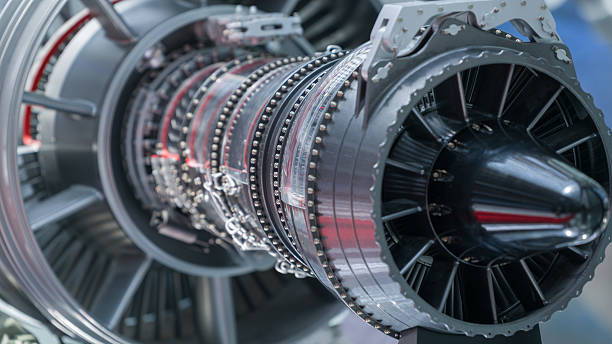
CNC-machined aircraft propeller
Accurate and precision machining is essential in making parts for the aerospace industry. Faulty parts cause several issues, ranging from minor glitches to catastrophic failures. This may result in expensive repairs, failed deadlines, or even fatalities. In the worst case, faulty components could cause a complete aircraft to crash.
This is when CNC machining enters the picture because it is the finest source of the precision and accuracy standards the aerospace industry needs for its manufacturing procedures. In reality, CNC machining can help you save a sizable sum of money by reducing expenses and production times. CNC machines can produce parts with incredibly exact dimensions and very tight tolerances.
Precision Machining Techniques for Aerospace Parts
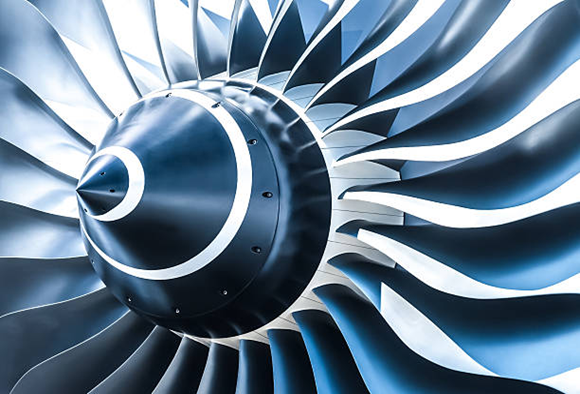
CNC-machined aircraft engine blade
Different things ensure precision in CNC machining for aerospace parts. Aerospace precision machining technique is one of them, and it consists of the following:
3-axis CNC Machining
Most of the requirements of the aerospace business are best met by 3-axis CNC machining. The three-axis CNC machine is a reliable workhorse for making components. It creates aerospace machined parts accurately and precisely, makes very little dust or noise, and is generally simple to use. It also has the advantage of working with various components and materials, including carbon fiber, aluminum, and stainless steel. One of the significant benefits of 3-axis machining is that it can produce parts at incredibly high speeds and machine parts in a very flat plane.
Related:
What Are the Different Ways to Make Aluminum Parts?
5-axis CNC Machining
5-axis CNC machining produces complex aircraft components. Parts can be milled, drilled, and moved along the X, Y, Z, and rotational planes using this method of aeronautical machining. These operations can take place simultaneously without fixture or reconfiguration. Complexity is valuable in the aircraft industry because it can help products become lighter. However, this is accomplished by creating parts that have complicated geometry or partial hollowing without compromising quality or performance.
Applications of Aerospace CNC Machined Parts
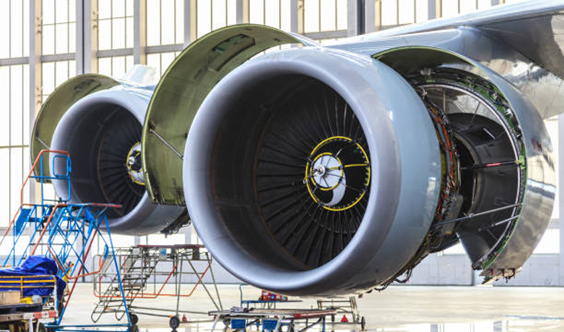
aircraft engine from the oblique front
CNC milling helps to create aerospace machined parts like hydraulic manifolds, transmissions, fuel bodies, landing gear, electrical connectors, housings, and many more. These components are ideal for a wide range of applications. Some of the applications of aerospace CNC machining include the following:
Space Travel
Companies like SpaceX and NASA are the first to come to mind when discussing space travel. These companies manufacture and responsibly develop the most advanced rockets and spacecraft for various tasks. However, they could only do this thanks to aerospace precision machining. This procedure is essential for producing even the smallest parts up to the rocket’s body construction.
As you are aware, it is essential to construct spacecraft that can withstand living in space. Once again, precision is essential. In addition to functioning correctly, parts must also guarantee the spacecraft’s safe operation. As a result, both the crew and the spacecraft are protected. CNC machining aircraft parts is the best method because it focuses on precision production.
Aviation
Accuracy is a crucial component of aircraft building, whether for passenger airlines, fighter jets, or cargo aircraft. Every step of an aircraft’s manufacturing must meet these accuracy standards. It includes both the outer shell and the deepest layer, leaving nothing out.
For instance, an airplane’s engine must maintain the aircraft in the air for the flight duration. As a result, the engine must effectively handle and use fuel. CNC aerospace machining also helps produce some of the essential parts vital to the running of the scalp.
The relevance of aerospace CNC becomes apparent when you consider the cockpit. A navigational system made up of a few tiny, interconnected parts aids in the movement of an aircraft. These aerospace components can be produced using CNC machining. A secure and effective flight can also be achieved by fine-tuning and adjusting essential components, such as the plane’s wings.
Common Aerospace CNC Machining Materials
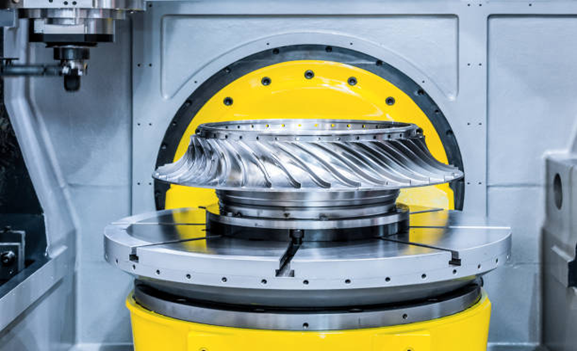
machining turbine wheels for aircraft
Most people only think of an aircraft’s engine or wing when discussing CNC aerospace machining. However, a plane is made up of millions of parts made from a wide range of materials.
These are some of the several materials used in aerospace CNC machined parts:
High-Performance Plastic
Many interior components are made of polymer-based materials, although metal components have more uses in an aircraft’s functional structures. Compared to metals, these materials are considerably lighter. They assist in producing components like interior wall panels, wiring conduits, aircraft doors, bearings, and more. They are aerospace-grade plastics, which are strong, light, and adhere to fire resistance standards.
CNC machining produces complex parts which are strong and lightweight for the aerospace business. PEEK and other high-performance polymers are used to make these components. Aerospace machining provides the high precision required for polymer-based aerospace applications, much like working with metals.
Lightweight Metals
The CNC machining materials that aerospace businesses use must possess two specific characteristics: strength and weight. Despite their power, steel and other strong metals are not the best materials for most components. This is because they are so heavy, which causes planes to use more fuel and be more costly.
Therefore, the aerospace business considers sturdy and lightweight metals like titanium and aluminum alloys. These two metal components are simple to work with and used in CNC machining. For instance, titanium is approximately 50% lighter and 30% sturdier than steel. It also has outstanding resistance to corrosion and high temperatures. Therefore CNC machining of titanium alloys is perfect for external and operational airplane parts.
Aluminum is only about half as durable, even though it is lighter than titanium. However, this highly machinable metal is more affordable than titanium. It is also appropriate for a variety of aviation parts.
Related:
3003 Aluminum vs. 6061 Aluminum: A Comprehensive Comparison Guide
CNC Machining Aerospace Parts: Challenges and Solutions
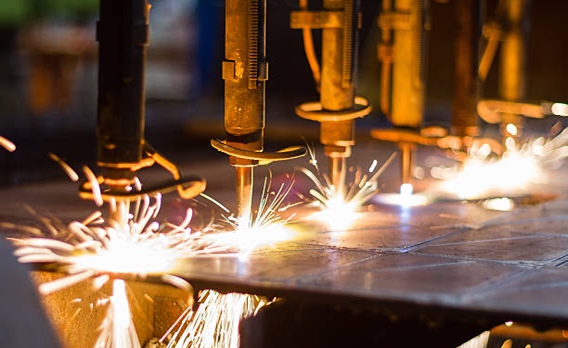
aircraft part machining
CNC machining produces aerospace components that are intricate and vary. As a result, it makes sense to set up many of these components on milling machines with five axes. 5-axis CNC machining operates machines using extremely accurate CNC. This procedure simultaneously moves parts and cutting instruments along up to five axes.
Thanks to this machine setup, the problem has gotten a solution as complex shapes can be produced. Continuous reconfiguration and adaptation of parts are feasible with 5-axis CNC machining due to the aerospace industry’s ongoing evolution. This robust method can better handle the complexity and range of aerospace components. Engineers can mill, drill, or manufacture them to the required aircraft specs.
A certain amount of danger is associated with 5-axis machining and aerospace manufacturing in general. However, with ProLean Tech, the possibility of mistakes can be minimal. We use a capable CAD/CAM device to ensure that. With efficient toolpaths, streamlined machining, and technical expertise, ProLean Tech offers comprehensive CNC machining services suited to the aerospace industry.
Conclusion
The aerospace sector is renowned for its high standards and quality requirements. Producing high-quality parts is essential because of how delicately aircraft are used. The industry’s required resolution is offered by aerospace CNC machining. To meet your requirements for aerospace manufacturing, ProLean Tech is prepared to pay attention to safety and risk management. Contact us today to get started!
FAQs
What Does an Aerospace Machinist Do?
A general understanding of the aviation sector and its components is preferable. Additional requirements include basic math abilities, attention to precision, manual dexterity, and familiarity with metal properties. In aviation manufacturing, an aircraft machinist uses a machine and specialty tools to create and fix parts.
Why Do Aerospace Companies Prefer CNC Machines Over Traditional Machining?
CNC equipment is made to be used continuously. There is less downtime because these devices need little maintenance. High productivity and reliable functioning are both made possible by this. This is a significant advantage for producers who operate under strict deadlines.
Is AutoCAD Used for CNC?
Because AutoCAD lacks integrated CAM capability, its use for CNC is constrained. However, most laser cutting facilities take the Autocad DXF format, and AutoCAD is frequently used to create 2D profiles for laser cutting. Technical 2D drawings and, in rare instances, simple 3D models are produced mainly using AutoCAD.




0 Comments